Luxury in a Time of Madness
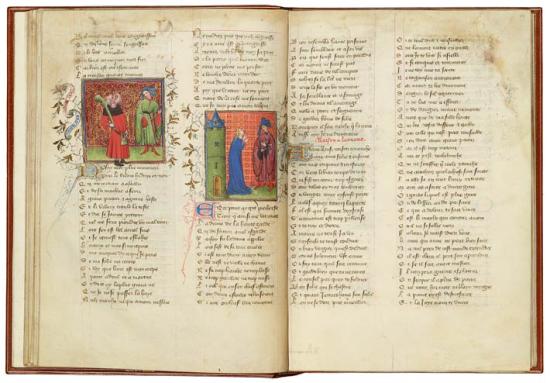
Romance of the Rose, in French
Purchased by Pierpont Morgan, 1900
The Lover Encounters Danger and Reason
The Lover, protagonist of the Roman de la rose, is always fashionably dressed. In these miniatures he encounters personifications of Danger (an old man with a club) and Reason (a crowned woman). In both scenes he wears the characteristic garment of this period, the houpeland. Both the green and purple houpelands are calf length and feature large poke sleeves. The floppy dagged sleeves of the pourpoint he wears beneath the houpeland are visible at his wrists. In both miniatures the Lover wears chaussembles and a blue chaperon with its cape and cornet tied up into the shape of a fish.
Luxury in a Time of Madness
In 1392 King Charles VI suffered the first of forty-four bouts of madness that would cripple his reign. During a lull in the Hundred Years' War, strife between France and Burgundy erupted into civil war. This domestic crisis was sparked by the 1407 assassination of Charles's brother by Duke John of Burgundy. In 1419 the duke, in turn, was murdered by supporters of the crown. During these tumultuous times, fashion reached unbelievable heights of luxury.
Men's and women's fashions were dominated by a new garment, the houpeland. Men's houpelands featured enormous sleeves and a skirt ranging from full length to crotch level. The pourpoint remained popular, albeit often finely embroidered and equipped with large sleeves. Accessories included fancy baldricks (sashes) and belts—both sometimes hung with bells. Tall bonnets or chaperons, often tied into imaginative shapes, completed the look.
Women's houpelands were always full length, with bombard or straight sleeves. The simpler cote hardy, with its voluminous skirt and tight upper body, continued to be worn. Women began to wear their hair in temples, a double-horned coif surmounted by veils or a tubular burlet.
Personification of the Church is Conservatively Dressed
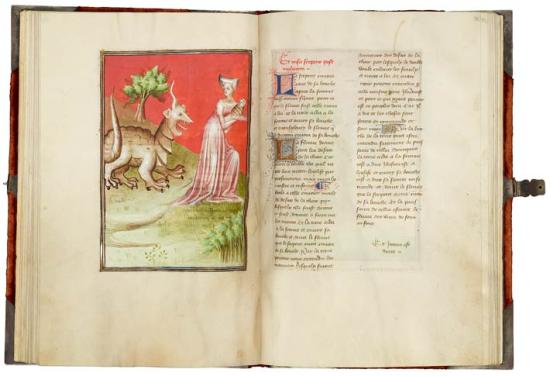
Apocalypse, with commentary, in French
Illuminated by the eponymous Master of the Berry Apocalypse
Purchased by Pierpont Morgan, 1910
The beast of the Apocalypse pursues a woman above whose head is inscribed L'eglise. Symbolizing the Church, this woman is purposefully not dressed in the period's luxurious houpeland. Instead, she wears only the traditional cote hardy. With its tight sleeves (worn here without tippets) and bodice but voluminous, trailing skirt, it is very much like the cotes hardy worn by the women in the previous section. Her headgear, too, is quite basic: double veils draped atop hair coiled over her ears.
Luxury in a Time of Madness
In 1392 King Charles VI suffered the first of forty-four bouts of madness that would cripple his reign. During a lull in the Hundred Years' War, strife between France and Burgundy erupted into civil war. This domestic crisis was sparked by the 1407 assassination of Charles's brother by Duke John of Burgundy. In 1419 the duke, in turn, was murdered by supporters of the crown. During these tumultuous times, fashion reached unbelievable heights of luxury.
Men's and women's fashions were dominated by a new garment, the houpeland. Men's houpelands featured enormous sleeves and a skirt ranging from full length to crotch level. The pourpoint remained popular, albeit often finely embroidered and equipped with large sleeves. Accessories included fancy baldricks (sashes) and belts—both sometimes hung with bells. Tall bonnets or chaperons, often tied into imaginative shapes, completed the look.
Women's houpelands were always full length, with bombard or straight sleeves. The simpler cote hardy, with its voluminous skirt and tight upper body, continued to be worn. Women began to wear their hair in temples, a double-horned coif surmounted by veils or a tubular burlet.
Like a (Well-Dressed) Virgin
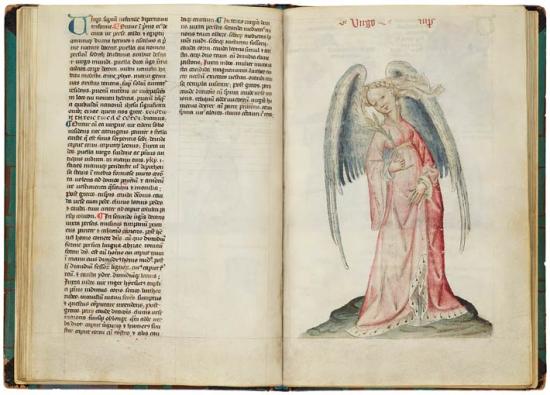
Astrological Treatises, in Latin
Purchased, 1935
In this astrological treatise, the zodiacal sign of Virgo (the Virgin) is represented by an extremely well-dressed maiden. She wears a trailing pink houpeland with bombard sleeves. The houpeland's skirt is luxuriously lined and hemmed with ermine, while its collar is lined with a second, tan fur. At her wrists we can see the sleeves of her symbolically pure-white cote hardy. As was the style, Virgo wears her belt very high, just beneath the bosom, over a gently swelling stomach. Her braided hair is uncovered; a simple transparent veil wafts from the back of her head.
Luxury in a Time of Madness
In 1392 King Charles VI suffered the first of forty-four bouts of madness that would cripple his reign. During a lull in the Hundred Years' War, strife between France and Burgundy erupted into civil war. This domestic crisis was sparked by the 1407 assassination of Charles's brother by Duke John of Burgundy. In 1419 the duke, in turn, was murdered by supporters of the crown. During these tumultuous times, fashion reached unbelievable heights of luxury.
Men's and women's fashions were dominated by a new garment, the houpeland. Men's houpelands featured enormous sleeves and a skirt ranging from full length to crotch level. The pourpoint remained popular, albeit often finely embroidered and equipped with large sleeves. Accessories included fancy baldricks (sashes) and belts—both sometimes hung with bells. Tall bonnets or chaperons, often tied into imaginative shapes, completed the look.
Women's houpelands were always full length, with bombard or straight sleeves. The simpler cote hardy, with its voluminous skirt and tight upper body, continued to be worn. Women began to wear their hair in temples, a double-horned coif surmounted by veils or a tubular burlet.
Portrait of the Author: Gaston Phoebus
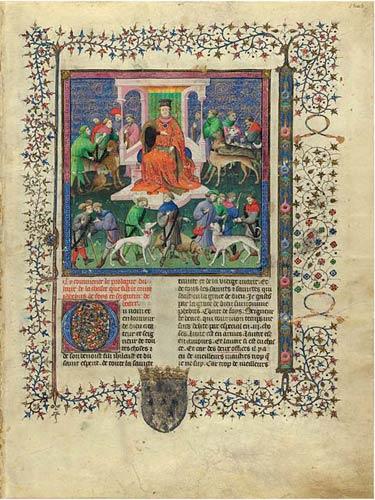
Livre de la chasse, in French and Latin
Illuminated possibly by the Josephus Master and the Bedford Master
Bequest of Clara S. Peck, 1983
Gaston III, count of Foix (1331–91), was called Phoebus because of his golden hair or handsome features. He composed this treatise on hunting and dedicated it to his fellow hunter, Duke Philip the Bold of Burgundy. The manuscript opens with an author portrait showing Gaston enthroned, directing the hunters and dogs gathered around him. He wears a voluminous fur-lined orange houpeland with elaborate gold embroidery and large bombard sleeves. The poke sleeve of his black pourpoint is visible on his right arm. The narrow cape of his chaperon is draped around his neck and a tall bonnet sits atop his head.
Luxury in a Time of Madness
In 1392 King Charles VI suffered the first of forty-four bouts of madness that would cripple his reign. During a lull in the Hundred Years' War, strife between France and Burgundy erupted into civil war. This domestic crisis was sparked by the 1407 assassination of Charles's brother by Duke John of Burgundy. In 1419 the duke, in turn, was murdered by supporters of the crown. During these tumultuous times, fashion reached unbelievable heights of luxury.
Men's and women's fashions were dominated by a new garment, the houpeland. Men's houpelands featured enormous sleeves and a skirt ranging from full length to crotch level. The pourpoint remained popular, albeit often finely embroidered and equipped with large sleeves. Accessories included fancy baldricks (sashes) and belts—both sometimes hung with bells. Tall bonnets or chaperons, often tied into imaginative shapes, completed the look.
Women's houpelands were always full length, with bombard or straight sleeves. The simpler cote hardy, with its voluminous skirt and tight upper body, continued to be worn. Women began to wear their hair in temples, a double-horned coif surmounted by veils or a tubular burlet.
The Well-Dressed Trainer of Huntsmen
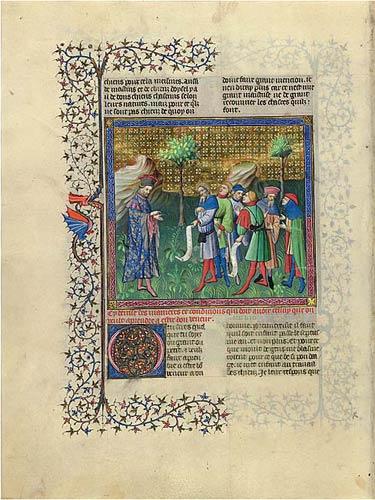
Livre de la chasse, in French and Latin
Illuminated possibly by the Josephus Master and the Bedford Master
Bequest of Clara S. Peck, 1983
Huntsmen, as young pages, were expected to know their hounds by name, appearance, and color. They are instructed in this miniature by an extremely fashionably dressed trainer. He wears a blue fur-lined, midcalf houpeland with gold embroidery and dagged bombard sleeves. Pink accents his collar and epaulettes as well as his matching chaussembles and the dagged sleeves of his pourpoint. His tall black bonnet is dramatically lined in red.
Luxury in a Time of Madness
In 1392 King Charles VI suffered the first of forty-four bouts of madness that would cripple his reign. During a lull in the Hundred Years' War, strife between France and Burgundy erupted into civil war. This domestic crisis was sparked by the 1407 assassination of Charles's brother by Duke John of Burgundy. In 1419 the duke, in turn, was murdered by supporters of the crown. During these tumultuous times, fashion reached unbelievable heights of luxury.
Men's and women's fashions were dominated by a new garment, the houpeland. Men's houpelands featured enormous sleeves and a skirt ranging from full length to crotch level. The pourpoint remained popular, albeit often finely embroidered and equipped with large sleeves. Accessories included fancy baldricks (sashes) and belts—both sometimes hung with bells. Tall bonnets or chaperons, often tied into imaginative shapes, completed the look.
Women's houpelands were always full length, with bombard or straight sleeves. The simpler cote hardy, with its voluminous skirt and tight upper body, continued to be worn. Women began to wear their hair in temples, a double-horned coif surmounted by veils or a tubular burlet.
No Bloodstains on These Clothes
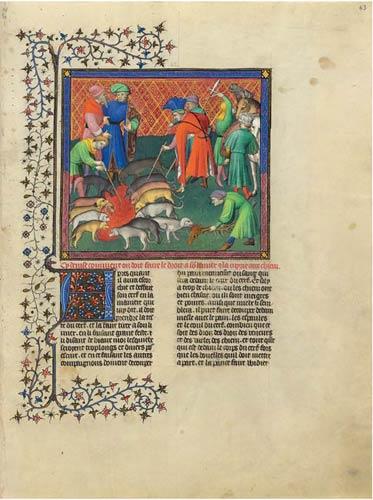
Livre de la chasse, in French and Latin
Illuminated possibly by the Josephus Master and the Bedford Master
Illuminated possibly by the Josephus Master and the Bedford Master
Two huntsmen wear the fashionable calf-length houpeland in this miniature. To the left, the man in the blue fur-lined houpeland also wears a capeline, or "bag hat" (as do the man he speaks with and the youth at the lower right). The "bag hat" would remain popular until around 1430. The other hunter wears an orange ermine-lined houpeland. His hat, with its crown of blue ostrich feathers, is the artist's invention. Behind him, two assistants wear their chaperons in imaginative ways. The cape of the yellow chaperon falls down the back of one helper, while the cape of the white chaperon worn by the other juts straight up, imitating a tall bonnet.
Luxury in a Time of Madness
In 1392 King Charles VI suffered the first of forty-four bouts of madness that would cripple his reign. During a lull in the Hundred Years' War, strife between France and Burgundy erupted into civil war. This domestic crisis was sparked by the 1407 assassination of Charles's brother by Duke John of Burgundy. In 1419 the duke, in turn, was murdered by supporters of the crown. During these tumultuous times, fashion reached unbelievable heights of luxury.
Men's and women's fashions were dominated by a new garment, the houpeland. Men's houpelands featured enormous sleeves and a skirt ranging from full length to crotch level. The pourpoint remained popular, albeit often finely embroidered and equipped with large sleeves. Accessories included fancy baldricks (sashes) and belts—both sometimes hung with bells. Tall bonnets or chaperons, often tied into imaginative shapes, completed the look.
Women's houpelands were always full length, with bombard or straight sleeves. The simpler cote hardy, with its voluminous skirt and tight upper body, continued to be worn. Women began to wear their hair in temples, a double-horned coif surmounted by veils or a tubular burlet.
The Fashionable in Pursuit of the Wolf
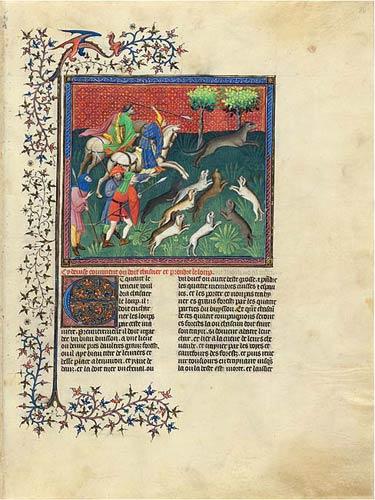
Livre de la chasse, in French and Latin
Illuminated possibly by the Josephus Master and the Bedford Master
While their motley crew follows on foot, two well-dressed hunters pursue the hated wolf on horseback. The huntsman in blue wears a fur-lined midcalf houpeland elaborately embroidered in red, white, and gold. Around his high waist is a gold belt from which fall gold chains terminating in bells. Orange provides the accent on his "bag hat" and matching chaussembles. Behind him rides a second hunter in a houpeland partied in green and pink and with especially large bombard sleeves. He wears an elaborate gold baldrick diagonally across his back. The rolled tube of cloth on his head is a burlet.
Luxury in a Time of Madness
In 1392 King Charles VI suffered the first of forty-four bouts of madness that would cripple his reign. During a lull in the Hundred Years' War, strife between France and Burgundy erupted into civil war. This domestic crisis was sparked by the 1407 assassination of Charles's brother by Duke John of Burgundy. In 1419 the duke, in turn, was murdered by supporters of the crown. During these tumultuous times, fashion reached unbelievable heights of luxury.
Men's and women's fashions were dominated by a new garment, the houpeland. Men's houpelands featured enormous sleeves and a skirt ranging from full length to crotch level. The pourpoint remained popular, albeit often finely embroidered and equipped with large sleeves. Accessories included fancy baldricks (sashes) and belts—both sometimes hung with bells. Tall bonnets or chaperons, often tied into imaginative shapes, completed the look.
Women's houpelands were always full length, with bombard or straight sleeves. The simpler cote hardy, with its voluminous skirt and tight upper body, continued to be worn. Women began to wear their hair in temples, a double-horned coif surmounted by veils or a tubular burlet.
Royals Dressed for Edifying Leisure
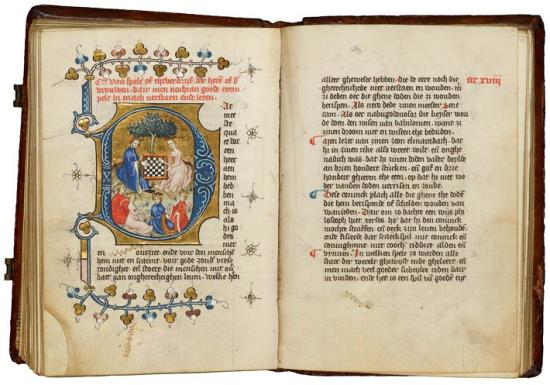
Table of Christian Faith, in Dutch
Illuminated by the Masters of Dirc van Delft
Purchased by J. P. Morgan, Jr., 1924
This is one of the earliest copies of the encyclopedia that van Delf wrote during the early fifteenth century. The miniature opens the chapter on games deemed suitable for royals; chess was considered an appropriate entertainment. A king and his queen play chess (although not with pieces, which the artist seems to have forgotten). He wears a luxurious fur-lined houpeland with a high neck and large bombard sleeves. His more humbly attired wife wears a simple cote hardy. A woman in a similar pink cote hardy plus two men and another woman in voluminous houpelands occupy the foreground.
Luxury in a Time of Madness
In 1392 King Charles VI suffered the first of forty-four bouts of madness that would cripple his reign. During a lull in the Hundred Years' War, strife between France and Burgundy erupted into civil war. This domestic crisis was sparked by the 1407 assassination of Charles's brother by Duke John of Burgundy. In 1419 the duke, in turn, was murdered by supporters of the crown. During these tumultuous times, fashion reached unbelievable heights of luxury.
Men's and women's fashions were dominated by a new garment, the houpeland. Men's houpelands featured enormous sleeves and a skirt ranging from full length to crotch level. The pourpoint remained popular, albeit often finely embroidered and equipped with large sleeves. Accessories included fancy baldricks (sashes) and belts—both sometimes hung with bells. Tall bonnets or chaperons, often tied into imaginative shapes, completed the look.
Women's houpelands were always full length, with bombard or straight sleeves. The simpler cote hardy, with its voluminous skirt and tight upper body, continued to be worn. Women began to wear their hair in temples, a double-horned coif surmounted by veils or a tubular burlet.
Delilah Dressed for Success
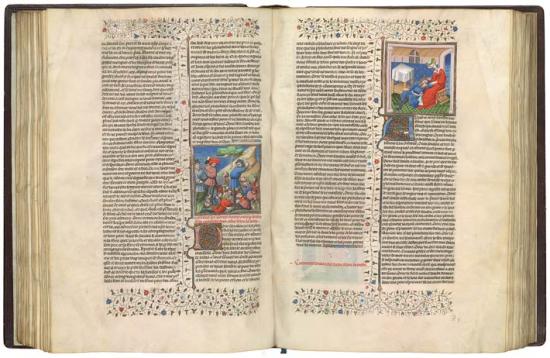
Bible historiale, in French
Illuminated by the workshop of the Boucicaut Master
Purchased by Pierpont Morgan, 1910
Taunted by the Philistines, a swashbuckling Samson slew a thousand of them with the jawbone of an ass, as depicted in the left miniature. They got their revenge, bribing Delilah to solve the mystery of his superhuman strength. She then got Samson drunk and cut off the source of his power — his hair. Delilah wears a trailing, high-waisted houpeland with bulbous sleeves and an open V-shaped collar. The horns of her temples (hennin), stretching wider than her shoulders, are surmounted by a decorative green burlet from which hangs a short veil. The horizontal embroidery and knotted sash worn by Samson signify his exoticism.
Luxury in a Time of Madness
In 1392 King Charles VI suffered the first of forty-four bouts of madness that would cripple his reign. During a lull in the Hundred Years' War, strife between France and Burgundy erupted into civil war. This domestic crisis was sparked by the 1407 assassination of Charles's brother by Duke John of Burgundy. In 1419 the duke, in turn, was murdered by supporters of the crown. During these tumultuous times, fashion reached unbelievable heights of luxury.
Men's and women's fashions were dominated by a new garment, the houpeland. Men's houpelands featured enormous sleeves and a skirt ranging from full length to crotch level. The pourpoint remained popular, albeit often finely embroidered and equipped with large sleeves. Accessories included fancy baldricks (sashes) and belts—both sometimes hung with bells. Tall bonnets or chaperons, often tied into imaginative shapes, completed the look.
Women's houpelands were always full length, with bombard or straight sleeves. The simpler cote hardy, with its voluminous skirt and tight upper body, continued to be worn. Women began to wear their hair in temples, a double-horned coif surmounted by veils or a tubular burlet.
St. Adrian as a Fashion Plate (Part 1)
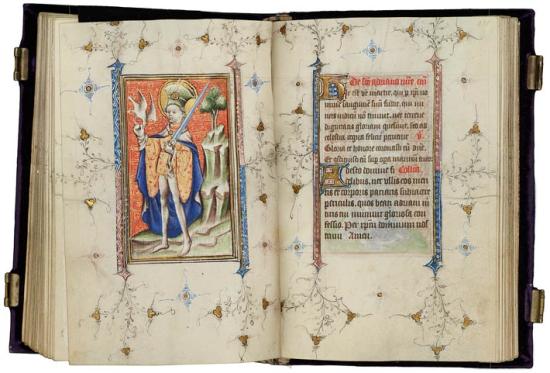
Book of Hours, in Latin
Illuminated by the Master of the Morgan Infancy Cycle
Purchased with the assistance of the Fellows, 1953
Adrian was a fourth-century pagan soldier before his conversion to Christianity, for which he was promptly martyred. Even by the standards of that era, his death was particularly brutal: his bones were crushed and his hands and head severed. In heaven his body — and his clothes — are resplendently restored. He wears a short embroidered pourpoint with luxurious poke sleeves. From his shoulders flows a long blue-lined cloak pinned at his throat with a gold morse. Chaussembles cover his lean legs and pointed feet, and he is crowned with a towering bonnet bedecked by a jeweled brooch with two feathers.
Luxury in a Time of Madness
In 1392 King Charles VI suffered the first of forty-four bouts of madness that would cripple his reign. During a lull in the Hundred Years' War, strife between France and Burgundy erupted into civil war. This domestic crisis was sparked by the 1407 assassination of Charles's brother by Duke John of Burgundy. In 1419 the duke, in turn, was murdered by supporters of the crown. During these tumultuous times, fashion reached unbelievable heights of luxury.
Men's and women's fashions were dominated by a new garment, the houpeland. Men's houpelands featured enormous sleeves and a skirt ranging from full length to crotch level. The pourpoint remained popular, albeit often finely embroidered and equipped with large sleeves. Accessories included fancy baldricks (sashes) and belts—both sometimes hung with bells. Tall bonnets or chaperons, often tied into imaginative shapes, completed the look.
Women's houpelands were always full length, with bombard or straight sleeves. The simpler cote hardy, with its voluminous skirt and tight upper body, continued to be worn. Women began to wear their hair in temples, a double-horned coif surmounted by veils or a tubular burlet.